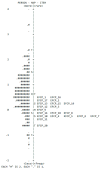Psychometric Properties of the Perceived Collective Family Efficacy Scale in Algeria
- PMID: 37830728
- PMCID: PMC10572840
- DOI: 10.3390/healthcare11192691
Psychometric Properties of the Perceived Collective Family Efficacy Scale in Algeria
Abstract
The Perceived Collective Family Efficacy Scale is a tool utilized to assess the effectiveness of a family as a functioning system. The scale has a single-factor structure with good validity and reliability. However, there is a shortage of psychometric evidence of the scale in an Arab context. This study aimed to assess the psychometric properties of the Perceived Collective Family Efficacy Scale among Algerian students. A cross-sectional study was conducted to recruit 300 students from Algerian universities. The students completed the 20-item Perceived Collective Family Efficacy Scale, Arabic version, to measure their beliefs regarding collective efficacy within families. Confirmatory factor analysis (CFA) and the Rasch model were employed to assess the psychometric properties and unidimensionality of the scale. Both CFA and Rasch findings supported the single-factor structure for the Perceived Collective Family Efficacy Scale. Specifically, the CFA indicated that the data aligned with a one-dimensional model. The Rasch analysis revealed favorable indicators of unidimensionality for the scale. Moreover, a thorough examination of the Principal Component Analysis of the Rasch residuals confirmed the existence of a single dimension, which is consistent with the original structure of the Perceived Collective Family Efficacy Scale. These findings provide scientific evidence for the validity and unidimensional nature of the Perceived Collective Family Efficacy Scale. Specifically, the satisfactory psychometric properties findings indicate that the Perceived Collective Family Efficacy Scale could be applied in an Arab context (i.e., in Algerian). The scale's unidimensional structure underscores its effectiveness in measuring beliefs in collective efficacy within families. These results enhance our understanding of family dynamics and provide a reliable measurement tool for assessing family efficacy in similar cultural contexts.
Keywords: Rasch model; collective efficacy; factor analysis; family; psychological theory; scales; self-efficacy.
Conflict of interest statement
The authors declare no conflict of interest.
Figures




References
-
- Gilbertson S., Graves B.A. Chapter 4—Heart Health and Children. In: Watson R.R., Zibadi S., editors. Lifestyle in Heart Health and Disease. Academic Press; Cambridge, MA, USA: 2018. pp. 35–46.
-
- McGinnis H.A., Wright A.W. Adoption and child health and psychosocial well-being. In: Halpern-Felsher B., editor. Encyclopedia of Child and Adolescent Health. 1st ed. Academic Press; Oxford, UK: 2023. pp. 582–598.
-
- Aiche S. Building a measure of functional family performance: A field study on a sample of respondents in Algeria. J. Educ. Qual. Res. 2021;8:167–182. doi: 10.21608/jeor.2021.65540.1000. - DOI
-
- Schermerhorn A.C., Mark Cummings E. Transactional Family Dynamics: A New Framework for Conceptualizing Family Influence Processes. In: Kail R.V., editor. Advances in Child Development and Behavior. Volume 36. JAI; Beijing, China: 2008. pp. 187–250. - PubMed
LinkOut - more resources
Full Text Sources

